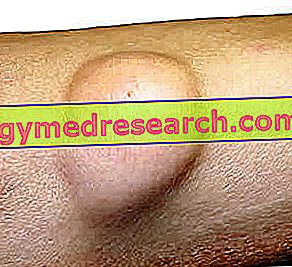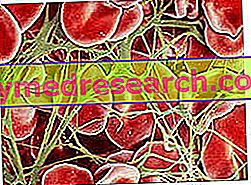Generality
Malassezia furfur is a yeast normally present on the skin surface of most of the healthy population. However, on some occasions, this microorganism behaves as an opportunistic pathogen, therefore it can give rise to localized and / or systemic infections.

Malassezia furfur can proliferate on the skin surface thanks to a peculiarity: these yeasts feed on the fatty acids present in the sebum and those deriving from the decomposition of skin cells; for this reason, they are considered real "diners".
In some susceptible individuals, infection by this microorganism can induce skin changes - such as scaly scabs, itching and redness - which, although localized, can be extremely annoying. Furthermore, Malassezia furfur can release substances that can modify the normal pigmentation of the skin, producing the appearance of unsightly whitish or brown spots.
In general, the treatment of the pathological conditions associated with the infection involves the use of antifungal drugs, to be applied locally to the skin or to be taken orally, according to the most appropriate regime indicated by the doctor.
Features
Malassezia furfur is a fungus (more specifically, a yeast) that can be found as a component of the normal skin flora of most healthy adults (90%).
Being a saprophyte of the skin, this microorganism is usually harmless, however, when certain conditions favorable to its proliferation are established, it can behave as an opportunistic pathogen .
Where is it
The colonization of the skin by these yeasts begins in the first three to six months of life and increases in the period in which the sebaceous glands become active. The concentration of Malassezia furfur increases, in fact, in a directly proportional way with respect to the concentration of skin lipids, presenting a peak in late adolescence and early adulthood.
This organism can be found more commonly in the chest, shoulders, arms and scalp. Malassezia furfur mainly colonizes the skin surface of people of Caucasian origin.
Appearance
Malassezia furfur usually has a spherical shape with a bottleneck end; the dimensions are approximately 1.5-4.5 microns in width and 2-6 microns in length. These yeasts are generally unicellular, but can form hyphae (ie long cylindrical filaments) when they become pathogenic.

Factors favorable to proliferation
The yeast finds the best situation for its own development in an environment with a high fat content (as lipophilic and lipid-dependent), especially in the summer, when the highest temperatures and high humidity rates favor sweating and increase of sebaceous secretions.
The proliferation of Malassezia furfur can also be due to an altered production of sebum or excessive humidity of certain body areas, secondary to the habit of wearing clothes that are not very breathable.
Other risk factors include immunodepression conditions, corticosteroid-based therapies, malnutrition, diabetes and other concomitant diseases.
Finally, the excessive proliferation of Malassezia furfur may depend on a personal predisposition (eg subjects with a tendency to seborrhea).
Role in dermatology
Malassezia furfur is considered the causative agent of various dermatological disorders, including pityriasis versicolor and seborrheic dermatitis. Furthermore, yeast appears to be implicated in the pathogenesis of psoriasis, folliculitis, dandruff and some forms of atopic dermatitis.
Pityriasis versicolor
Malassezia furfur is a fungus known primarily for its pathogenetic role in pityriasis versicolor. This skin infection is manifested by the appearance of irregular flat and discolored spots (hypo- or hyperpigmented, with a color ranging from white to brown); the locations mainly involved are the neck, trunk, abdomen, shoulders, arms and face.
Pityriasis versicolor lesions may be associated with itching, scaling and irritation.
Risk factors for the disease include increased sebaceous secretions, immunosuppression and the combination of hot-humidity.
The diagnosis is based on the clinical appearance of the lesions and on the examination of skin scarifications. The treatment of pityriasis versicolor involves the use of topical antifungal drugs (in the presence of a localized infection) or systemic (in the case of extensive disease or frequent relapses).
Seborrheic dermatitis
Seborrheic dermatitis is a skin inflammation due to too rapid multiplication of skin cells, associated with high activity of the sebaceous glands. The disorder is common especially in male subjects 30-40 years of age.
Available scientific evidence suggests that Malassezia furfur may promote seborrheic dermatitis, in combination with other host factors. These include genetic predisposition, changes in the quantity and composition of sebum, stress and increased skin alkalinity (due to sweating). Patients suffering from neurological disorders (such as Parkinson's disease) and those with AIDS are more frequently affected.
The clinical manifestations of this disease include erythema with itching and flaking, especially in areas rich in sebaceous glands (scalp, face, eyebrows, ears and upper part of the trunk). The skin becomes covered with dry or yellowish greasy scales (dandruff); in the most serious cases, papules appear red-yellowish to the insertion of the hair.
The diagnosis is made by the dermatologist with the physical examination. Regarding treatment, the use of topical imidazole is generally indicated. If necessary, corticosteroids can also be prescribed.
folliculitis
Malassezia furfur can cause an itchy eruption characterized by papules and pustules at the hair follicles, often after exposure to the sun. These lesions are located mainly in the back, chest and arms.
Scrapings or biopsy samples show the occlusion of hair follicles involved in the infectious process. Most cases respond well to topical treatment with imidazole; however patients with extensive lesions often require oral treatment with ketoconazole or itraconazole.
Onychomycosis
Malassezia furfur can be a cause of onychomycosis, a nail infection that causes alterations such as fragility, fissures and the formation of opaque white patches.
However, this disease is more likely to be caused by other species of fungi, including Candida albicans .
Dandruff
Malassezia furfur can colonize the scalp thanks to the fat contained in the sebum.
In the presence of increased sebaceous secretion, this micro-organism proliferates and produces some irritant metabolites that cause inflammation. In the most serious cases, it can manifest itself, in addition to dandruff, also itching and redness of the scalp.
Other skin disorders
Other skin diseases caused or aggravated by Malassezia furfur infection include:
- Confluent and reticulated papillomatosis of Gougerot-Carteaud : pigmented eruption that occurs mainly on the chest, back and neck of adolescent girls;
- Neonatal cephalic pustule : dermatosis that appears in the first days of life, characterized by the appearance of a pustular eruption on the face or scalp, similar to acne.
Other associated pathological conditions
In addition to skin diseases, Malassezia furfur may be implicated in a wide range of other clinical manifestations, including:
- Allergies. Some products of the metabolism of Malassezia furfur can cause allergic reactions. Potential allergens include Mala f2 and Mala f3 (peroxisomal membrane proteins) and Mala f4 (mitochondrial dehydrogenase malate). In this case, specific IgE antibodies against Malassezia and Prick positive tests can be found for the microorganism.
- Fungemia . In immunosuppressed patients, Malassezia furfur infection can give rise to localized and / or systemic mycoses, following the spread of the microorganism in the bloodstream, with the possibility of developing pneumonia and peritonitis.
Yeasts can become opportunistic pathogens, especially in infants and debilitated adults who receive infusions via central venous catheters or undergo total parenteral nutrition or lipid solutions. The high temperature and humidity can facilitate the colonization of the insertion site of percutaneous catheters.
More rarely, Malassezia furfur yeast has been found in cases of septic arthritis, mastitis, sinusitis, tear duct obstruction and urinary tract infections.
Diagnosis and treatment
The diagnosis of cutaneous infection by Malassezia furfur is based on the clinical appearance of superficial lesions and on histological or cytological examination of a tissue sample. Examination of the areas involved, with an ultraviolet Wood lamp, shows a clear golden fluorescence emitted by the fungus colonies.
The identification of Malassezia furfur can be confirmed by direct observation of the pathogen and the positivity of laboratory cultures. The material to be examined is represented by samples of cutaneous scarifications (in the presence of superficial lesions) or blood (in case of suspected fungemia).
The in vitro growth of the micro-organism includes specific supports and must be stimulated by natural oils or other fatty substances. The feedback can be supported by the application of molecular techniques.
The direct observation under the microscope of Malassezia furfur uses fresh preparations of potassium hydroxide (KOH), which make it possible to highlight the presence of groups of yeast cells and long filaments (hyphae).
The treatment of Malassezia furfur infection depends on clinical manifestations and, in general, involves the use of the most appropriate antifungal drugs, to be applied to the skin or to be taken orally, according to the indications of the dermatologist specialist.
The doctor may also prescribe a prophylactic therapeutic regimen with a topical agent to prevent recurrences. Furthermore, to avoid relapses it is important to observe an accurate hygiene and choose clothing made with natural fabrics (not synthetic).



